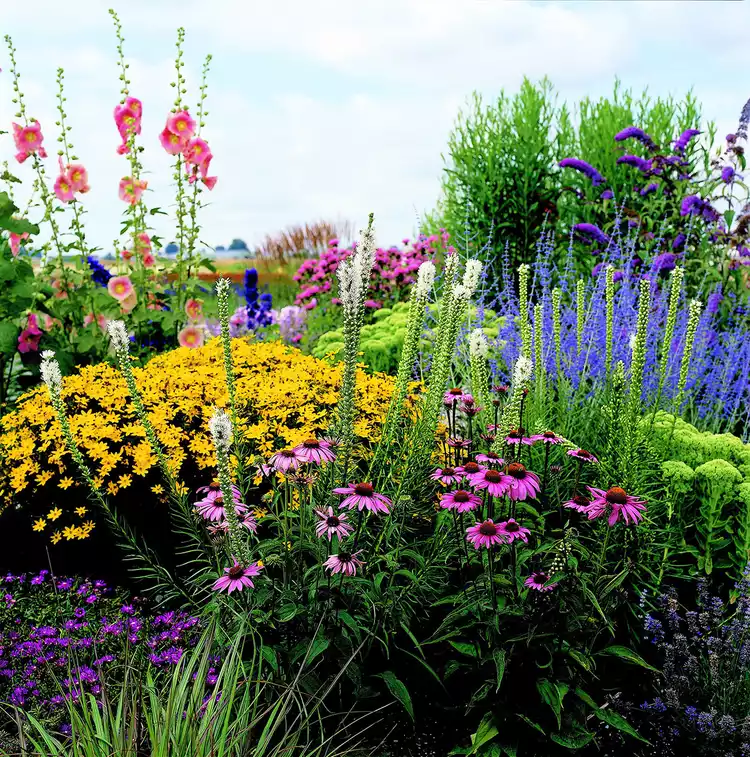This Full-Sun Garden Plan Brings Color to Your Whole Yard

Geraniums, marigolds, and other short-lived annuals are one option for planting a successful flower garden in a hot, sunny spot, but they need to be replanted every spring. Plenty of blooming perennials also can take the heat, but will come back every year after the winter without you having to do anything. This simple garden plan artfully combines a selection of sun-loving perennials together so that the bright yellows, purples, and pinks of their flowers will create an eye-catching display for several weeks. Use this design to fill a challenging, full sun area in your yard with multiple colors and textures that will last all summer.
Plants for Creating the No-Fuss Sun-Loving Garden Plan
- 1 New England aster (Symphyotrichum novae-angliae): Zones 4-8
- 3 Tickseed (Coreopsis 'Lil Bang Daybreak'): Zones 4-9
- 2 Coneflower (Echinacea purpurea 'Powwow Wild Berry'): Zones 3-9
- 1 Hollyhock (Alcea rosea): Zones 3-9
- 3 Blazing star (Liatris spicata 'Floristan Weiss'): Zones 4-9
- 1 Butterfly bush (Buddleia 'Chrysalis Blue'): Zones 6-9
- 1 Russian sage (Perovskia atriplicifolia): Zones 5-9
- 1 Sedum 'Autumn Joy': Zones 3-10
- 1 Lavender (Lavandula angustifolia 'SuperBlue'): Zones 5-8
The back layer of this vignette is built with hollyhock, butterfly bush, and Russian sage. Their tall spires of flowers add height that will do well against a fence or wall. Tickseed, blazing stars, and coneflowers serve as mid-height layering plants. The spaces around the edges of the garden plan are filled with low-growing lavender, sedum, and asters for a lush and polished finish.
If you aren't able to find the exact varieties listed above, substitute with others that have similar colors, shapes, and sizes. And because some plants can become overly aggressive and spread out of control in certain climates, always check which species are considered invasive in your area before planting.
Get the Free No-Fuss Sun-Loving Garden Plan
This free garden plan is available as a printable PDF that includes an illustrated version of the planted garden, a layout diagram, a list of plants for the garden as shown, and complete instructions for installing the garden.
Tips for Planting Your New Garden
Preparation is the key to creating a garden that will offer a lifetime of pleasure. Before you start plant shopping, review all garden plan materials. Then, ask yourself the following questions:
Do I have a suitable spot for this plan?
The layout diagram shows the rough dimensions for the plan. In general, you can enlarge or reduce the size of the garden by adding or eliminating plants, although the character of the garden may change if you alter the size dramatically.
Do I have the right growing conditions?
Check the plant list to see if the plan will do best in sun, part shade, or full shade. Be sure that the plants are suited to your USDA Hardiness Zone.
Do I need to amend my soil?
Most plants thrive in moist, but well-drained soil. If you have soil with lots of sand or clay, amend it liberally with lots of organic matter, such as compost. You may also want to do a soil test to see if you need to adjust the soil pH or add fertilizer before planting.